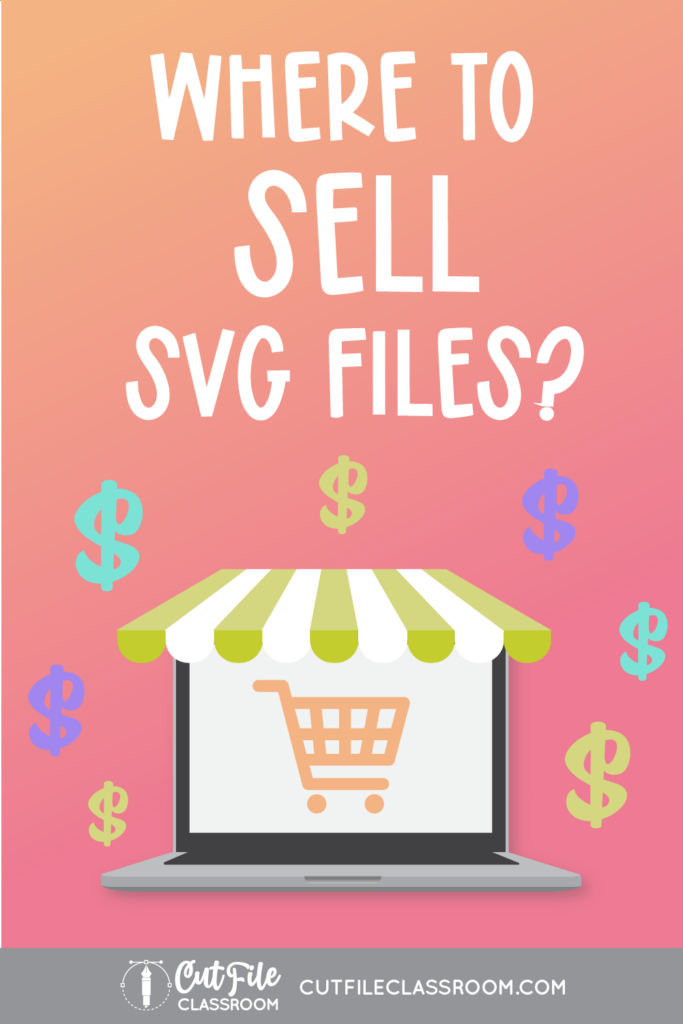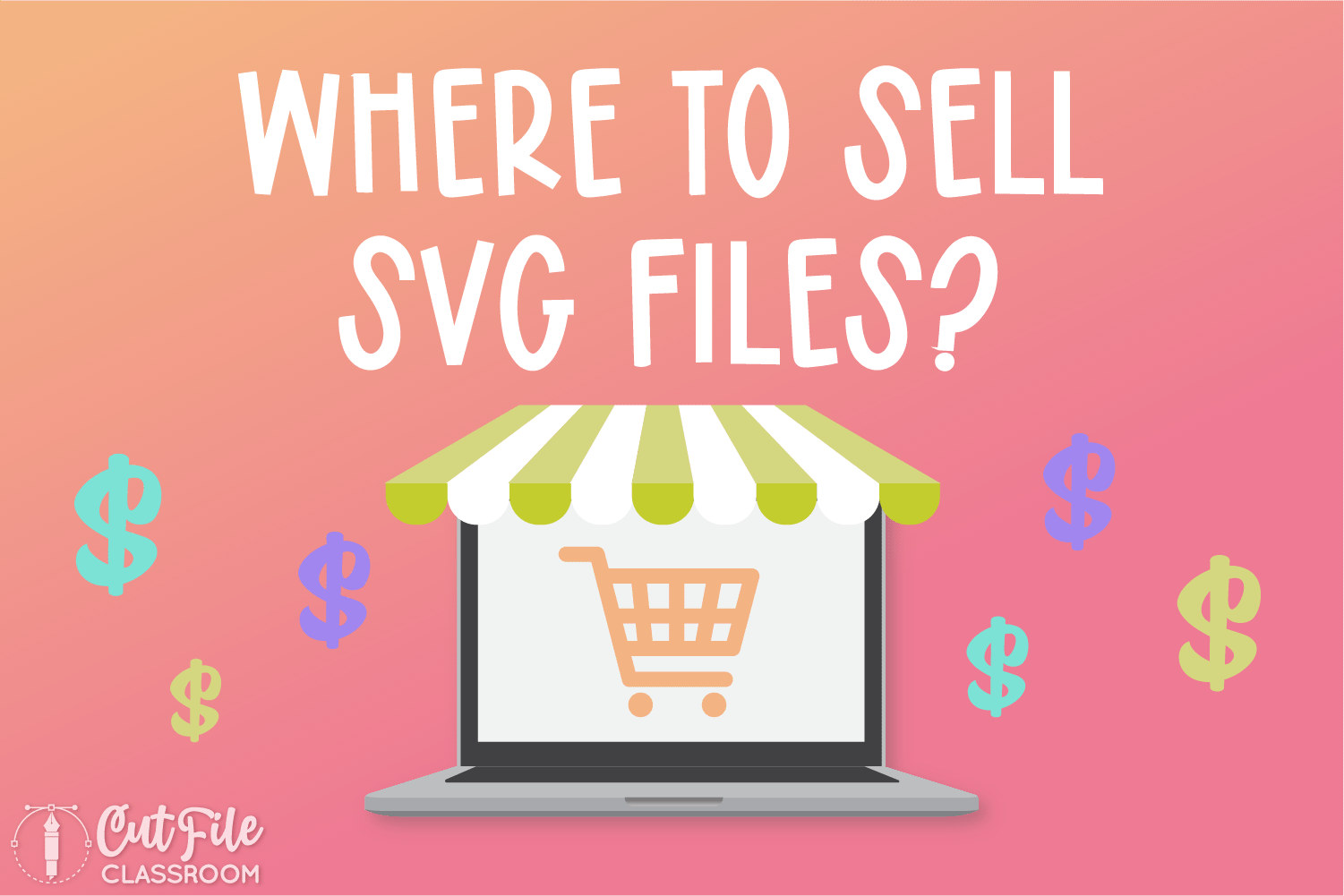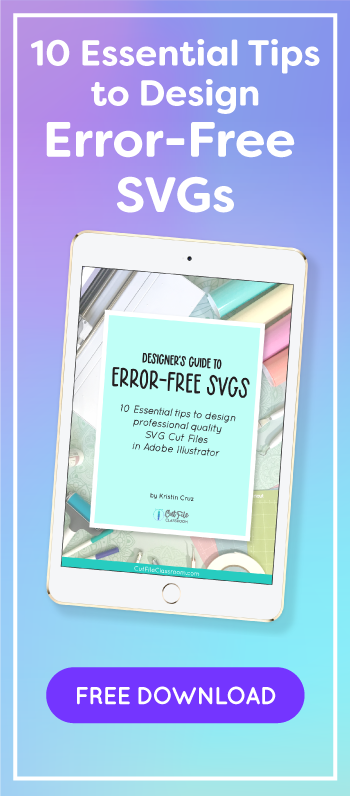Wondering where to sell SVG files? Whether you’re just starting an SVG business, or you’ve been at it for awhile and looking to expand your reach, figuring out where to showcase your cut file designs is kinda like finding the right font – challenging but crucial.
Is it better to sell SVGs on your own website – carving out your own corner on the web? Or should you sell on a marketplace where traffic and visibility may be easier to come by? It’s a tug of war between freedom and visibility, control and convenience, and as someone who has done both in my SVG business, I’m here to break down the details.
Table of Contents
Pros of Selling SVG Files on Your Own Website

Control and Flexibility: You Call the Shots
When you own your own website, you get to make the rules! YOU decide how to price, license, package, and promote your designs. And you keep more of the profits for all of your hard work. You dictate the look, feel, and messaging of your own site, creating a unique presentation and experience that represents your brand and connects with your audience.
Your site serves as a home base for your business. Not only can it house your shop, but you can share crafting tutorials or project inspiration, offer discounts, freebies, host giveaways, challenges, and any other fun content you can dream up for your brand – (all of which will help bring traffic your way)!
Direct Customer Interaction: Build Relationships

With your own website, you get to establish a direct line to your customers. You have the chance to connect with them and keep in touch with them. They can get to know you and your brand through tutorials, project inspiration, freebies, discounts etc. Your site analytics will also give you insights into how they found your site, which pages and products are viewed the most, and other valuable information that you can use to get to know you audience and better serve them with more of what they’re looking for.
Aside from Etsy, most marketplaces don’t provide direct access to customers. So when someone buys your designs on a marketplace, they’re not really “your” customer – they’re a customer of the marketplace.
Have you ever noticed when someone shares a project in a crafting group and gets asked, “Where did you get that file?” the answer is usually”I got it from Etsy” or “from DesignBundles”? Rarely does anyone recall and mention the actual designer’s name when buying SVGs from a marketplace.
When customers interact directly with your website, they will come to know and trust your specific brand by name – and refer it to others.
Branding and Identity: Showcase Your Unique Style
Selling SVG designs on your own site gives you an amazing chance to really shape your brand. When you own your own space online, it’s like creating your very own world where everything reflects your style, values, and personality. You’re in charge here – from how your designs are presented, the stories behind them, right down to how people browse, buy, and even get in touch with you.
It’s so much more than just listing your design for sale; you get to craft a whole customer experience. From the moment someone lands on your site to the happy dance they do when they download your creations. It’s all about you and your unique brand, every step of the way.
Cons of Selling SVGs on Your Own Website

Tech Headaches: Initial Setup and Maintenance
Make no mistake, running your own website comes with its’ own challenges.
The initial setup of a website can be a bit techy; but once you’re up and running, you’ll have a valuable home base for your business where you’re not subject to the constant changes that marketplaces impose on sellers.
Getting your own site setup involves choosing hosting, setting up payment methods, and creating your site and shop. While some tech-savviness is helpful, building your own website is becoming incredibly user-friendly. Nowadays, there are so many options available that make it easier and don’t require touching any code. Plus there are plenty of guides and support out there to lend a hand when you get stuck.
Once your site is built, you’ll also need to stay on top of maintaining it – keeping plugins and add-ons updated and staying on top of taxes and other legal requirements (such as GDPR rules that were introduced a few years ago).
While this may all seem daunting at first, if you “eat the elephant one bite at a time”, you’ll find that breaking it down into smaller steps and tackling each task one at a time will help you get through it. You’ll gain a wealth of knowledge over time and find yourself handling it all like a Pro. And at the other end of the tunnel, you’ll have a valuable asset you can call your own. To me, the freedom of not being dependent solely on marketplaces is well worth it!
DIY Traffic: SEO & Marketing
When you sell SVG designs on your own site, you are responsible for bringing in your own traffic – so you’ll need to learn SEO and marketing. Both are powerful and important tools to help get more people to find and visit your website.

SEO (Search Engine Optimization) means tweaking certain parts of your website so Google and other search engines notice you, making it easier for people to find you when they’re searching online.
Marketing is basically how you show off your products in different places, like social media, video tutorials, or email campaigns, to grab people’s attention and bring them to your site.
You’ll need to learn both of these skills anyway no matter where you sell! So the way I see it: why invest time mastering SEO and marketing just to drive traffic to someone else’s platform, when you could be doing all that work to attract people to your own site?
While you might not bring in anywhere near the amount of traffic that a marketplace can, the visitors you attract are coming directly to YOU! Once they land on your site, it’s all about your awesome designs – no distractions, no detours to other shops. It’s your time to shine!
Pros of Selling SVG Files on Marketplaces
Diversify your Income
Don’t get me wrong, it’s definitely smart to sell your SVGs in more than one place. Design once and sell over and over in different shops! With digital products, you’ve already done the work to create your designs; selling them on more than one platform allows you to create multiple income streams with the same product. That’s the beauty of passive income!

Plus it’s always a good idea to have income coming in from multiple places. If one marketplace is having a dip in sales, their site goes down, or other difficulties (such as the delay in Etsy payouts due to the Silicon Valley Bank crash), you’ll still have at least some income coming in from your other sources.
Different marketplaces also have different audiences, so some of your designs that don’t sell well on one platform might be best-sellers on another.
Simplicity: Hassle Free Setup
If you’re just getting started selling SVGs online, or selling as a side gig, then starting your own website might be more than you want to deal with right now. Selling your digital designs on a marketplace is a great way to test the waters and start making some income.
Marketplaces make it very easy to get your shop up and running, and it’s usually very easy to upload your designs and get them listed for sale. They also handle sales tax and other requirements that make the business end of selling a lot less scary.
Built-in Audience & Exposure Boost
Marketplaces bring in a lot of traffic, allowing you to reach a wider audience than you likely will on your own. Niched platforms like SoFontsy or Cricut Design Space that focus solely on cutting machine crafters also deliver your ideal customer right to you!
IMO a good Marketplace will do most of the promoting to bring in traffic, and supply a good algorithm to help relevant designs get found, while your job as the designer is to create quality designs and make sure they are optimized (both visually and for SEO). This also gives you one less thing to worry about and allows you to focus more on designing.
Many graphics-based platforms will curate bundles, freebies and discounts that they promote heavily to their audience. If your designs are chosen for these types of promotions, it can give your shop a great boost of exposure, and may also lead to a nice little increase in payouts that month!
Cons of Selling SVGs on Marketplaces
Cutting Through the Competition
A built-in audience of millions is an appealing reason to join a marketplace. With that many people, your designs are bound to make tons of sales, right?
But keep in mind that there are also thousands of other shops on those marketplaces competing for those sales. On marketplaces, customers are constantly diverted to other shops at every turn. When your design comes up in a search on a marketplace, there will also be recommendations for similar designs from other shops right next to yours – even on your product listing page! In a world already full of distractions, how will you stand out from the crowd?

In an ideal world, a good marketplace will bring the traffic to you, but in reality, not all platforms do a great job of promoting relevant designs equally. Some platforms focus heavily on a few top selling shops, massive bundles of designs, or have poor search algorithms which makes it harder to stand out and be seen.
Some marketplaces also put a heavy emphasis on designers promoting and bringing traffic to the platform. This always seemed a little backwards to me, especially when considering the hefty fees that are taken from designer payouts.
If I’m going to spend that much time and effort driving traffic, I’d rather drive it to my own site and keep more of that purchase price for my efforts!
Here Today, Gone Tomorrow
Keep in mind that marketplaces can and DO rise and fall. Since I began selling SVGs in 2015, I’ve seen the rise and fall of several different platforms. Some marketplaces that were on top or seemed promising, have fallen out of popularity or completely flopped. (Anyone other designers remember scrambling to upload listings to the ACMoore Marketplace that was pretty much DOA?)
I’ve also seen new marketplaces emerge and quickly grow and overtake previous leaders to dominate the industry.
The tricky thing is, there’s really no way to know which ones will pan out. I remember in my early days, being invited to a new and promising looking platform, excitedly prepping and uploading as many designs as I could in a frenzy, only for that marketplace to end up being one of my lower performing platforms.
Since then, I’ve made it a personal rule not to devote too much of my time and energy on platforms unless they prove to be worth my time and effort – and even then, my website still comes first.
Sadly, I’ve seen designers fall into this trap time and time again – focusing all of their time, effort, and designs onto just one shiny platform and even making it their home base – only to have it dwindle over time or flop right out of the gate.
Commissions and Control: The Price of Convenience
So marketplaces like Etsy and Creative Fabrica make it super easy to set up shop, get some exposure, and start selling your designs. But what’s the catch?
Firstly, they need to be compensated for their services, so you’ll need to pay some sort of commission, either as an upfront listing fee, or a percentage of your sales – or both.

While most graphics marketplaces split a-la-cart purchases 50/50, some have shifted their focus to subscription models, which sadly doesn’t benefit designers.
Low-cost “all access” subscriptions are great for the customer – giving them access to thousands of designs they can download at any time. However designers get paid pennies per sale. I’ll dive deeper into the specific commissions of different platforms in my next post, but to me the math ain’t mathing.
In addition to fees and commissions, when you sell on someone else’s turf, you have to play by their rules. What you get in convenience, you give up in control. You’re subject to their pricing requirements, licensing terms, fee increases, rating systems, algorithm changes etc.
Etsy has become notorious for imposing new (often unwanted) requirements on sellers, from their Star Seller Badge and Offsite Ads, to their constant algorithm changes, image size changes etc. etc.
Some Etsy shop owners have also had the nightmare of waking up to find their shop was suddenly shut down – sometimes due to an automated error, and then have to fight to get in touch with a live person to get things sorted out – losing sales in the process.
Less than a year ago, Design Bundles was a favorite marketplace for many designers to sell SVGs and other digital designs. However, in mid-2023, the site made several substantial changes to its’ business model, which included a heavy shift towards their subscription model and AI generated art. This abrupt change hit many designers’ incomes pretty hard (see what I mean about the rise & fall of different platforms?).
Put pretty simply: You don’t own your space on platforms – you’re just renting. You don’t own Etsy, or Design Bundles, or Facebook. These are all wonderful tools to help expand your product reach, but ultimately you’re putting your business at someone else’s mercy.
So Where to Sell SVG Files?
If you’re still not sure where to sell SVG files, I personally recommend a combination of selling on both your own website and a few marketplaces to maximize your earnings – with a focus on your own website. I currently sell SVG files on 4 different platforms in addition to my own site.
When I first started selling SVGs in 2015, there was no DesignBundles. No Creative Fabrica. No SoFontsy. Etsy was pretty much the only place to sell SVG files, aside from your own website. So I started with my own website, and slowly added other platforms over the years.
I believe strongly in the importance of owning your own space on the web, even with the ease and allure of platforms and marketplaces.
Above all, my website is and has always been my #1 focus in my business. The VAST majority of my efforts uploading designs, blog posts, social media, marketing emails etc, goes towards my own site. Designs are always uploaded to my own website before any other platform, and my website is the only place where customers can find all of my designs.
While selling on marketplaces is a great way help your digital products work harder for you, diversify your income and get your designs to reach a wider audience; I can’t stress enough that you don’t own them and I would caution against making just one platform your “home base”.
You don’t want to spend all of your time nurturing one platform only to watch your income drop due to policy or ownership changes, algorithm changes, or just good ol’ fashioned competition.
You can start small and simple with your own website. Buy the domain for your brand name, and start with just a single webpage that can serve as your home base, even if it links to your shop on other marketplaces at first.
Be sure to include a place for visitors to sign up for your email list – another must-have to grow your own audience (more on that another day).
Over time, you can add a blog section with relevant project tutorials showing off your designs, which will help your site build traffic. Eventually consider adding a shop to your site to sell your designs so you won’t be reliant on marketplaces alone.
Building and maintaining a website and growing a following is more time consuming and comes with its’ own challenges, but at the end of the day, you OWN it all, and get to keep more of the profits from your hard work!
In my next post, we’ll dive deeper into marketplaces. I’ll talk about the best places to sell SVG files, and share my experiences on several leading platforms. I’ll also mention a few other places to sell SVG files online, along with why I’ve chosen not to pursue them.
Pin this post for future reading and to help others trying to decide where to sell SVG files!





